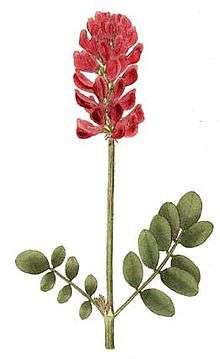Hedysarum
| Hedysarum | |
|---|---|
 | |
| Hedysarum coronarium | |
| Scientific classification | |
| Kingdom: | Plantae |
| (unranked): | Angiosperms |
| (unranked): | Eudicots |
| (unranked): | Rosids |
| Order: | Fabales |
| Family: | Fabaceae |
| Subfamily: | Faboideae |
| Tribe: | Hedysareae |
| Genus: | Hedysarum L. |
| Synonyms | |
|
Corethrodendron Fisch. & Basiner | |
Hedysarum (sweetvetch) is a genus of the botanical family Fabaceae, consisting of about 309 species of annual or perennial herbs in Asia, Europe, North Africa, and North America.
Description
Species within Hedysarum genus may be herbaceous plants or deciduous shrubs. They have odd-pinnate leaves, with entire leaflets (no notches or indentations). These leaves resemble the leaves of sweet peas. The stipules may be free or connate, and stipels (secondary stipules) are absent.
The inflorescences are peduncled racemes or heads. Bracts are small, with bracteoles below the calyx, and calyx teeth subequal. The petals may be pink, purplish, yellow, or whitish. Vexillum is longer than the wings, with an obtuse keel longer or rarely shorter than the wings. Stamens are diadelphous, 9+1, and anthers uniform. Ovary is 2-8-ovuled. Fruit is a lomentum, with segments that are glabrous, pubescent, bristly, or spiny. [2]
Uses
Hedysarum species are used as food plants by the larvae of some Lepidoptera (moth and butterfly) species including Coleophora accordella. Some species, such as Hedysarum alpinum also known as Alpine Sweetvetch or Wild Potato, were eaten by the Inuit to help ward off the effects of scurvy due to it being rich in vitamin C, containing about 21 mg/100g.[3] Charles Darwin also called the telegraph plant a Hedysarum.
In his book Into the Wild, Jon Krakauer incorrectly speculates that Christopher McCandless died from eating seeds of H. alpinum, which Krakauer further speculates to contain swainsonine. This theory was later debunked by experts in the field of botany. [2] Krakauer subsequently postulated that these seeds were stored wet in a plastic bag, which may have created a toxic by-product, but again there is no evidence to support this claim.
Krakauer was later validated, to a certain extent. Krakauer explains that he recently came across the research of a writer, Ronald Hamilton, who had concluded that a neurotoxin, known as ODAP, in the wild potato seed was responsible for a degenerative disease known as lathyrism. In August 2013 Krakauer sent a modest sample of the seeds for testing, discovering that they contained ".394 per cent beta-ODAP by weight, a concentration well within the levels known to cause lathyrism in humans." Krakauer concludes that "Had McCandless’s guidebook to edible plants warned that Hedysarum alpinum seeds contain a neurotoxin that can cause paralysis, he probably would have walked out of the wild in late August with no more difficulty than when he walked into the wild in April, and would still be alive today." [4]
Wildlife
The roots are a major food for grizzly bears. [5]
Selected species
- Hedysarum aculeolatum Boiss.
- Hedysarum alpinum L. - Alpine Sweetvetch
- Hedysarum arcticum B. Fedtsch.
- Hedysarum argyreum Greuter & Burdet
- Hedysarum argyrophyllum Ledeb.
- Hedysarum armenum Boiss. & Tchich.
- Hedysarum atropatanum Boiss.
- Hedysarum biebersteinii Chrtková
- Hedysarum bordzilovskyi Grossh.
- Hedysarum boreale Nutt. - Utah Sweetvetch
- Hedysarum boutignyanum (A. Camus) Alleiz.
- Hedysarum boveanum Basiner
- Hedysarum candidum M. Bieb.
- Hedysarum cappadocicum Boiss.
- Hedysarum carnosum Desf.
- Hedysarum coronarium
- Hedysarum cretaceum DC.
- Hedysarum cyprium Boiss.
- Hedysarum daghestanicum Boiss.
- Hedysarum elegans Boiss. & A. Huet
- Hedysarum flexuosum L.
- Hedysarum formosum Basiner
- Hedysarum fruticosum Pall.
- Hedysarum glomeratum F. Dietr.
- Hedysarum gmelinii Ledeb.
- Hedysarum hedysaroides (L.) Schinz & Thell.
- Hedysarum ibericum M. Bieb.
- Hedysarum jaxartucirdes Y. Liu ex R. Sa
- Hedysarum kemulariae Sachokia & Chinth.
- Hedysarum kotschyi Boiss.
- Hedysarum macedonicum Bornm.
- Hedysarum membranaceum Coss. & Balansa
- Hedysarum micropterum Boiss.
- Hedysarum mongolicum Turcz. - Sweetvetch
- Hedysarum multijugum Maxim.
- Hedysarum naudinianum Coss. & Durieu
- Hedysarum occidentale Greene - Western Sweetvetch
- Hedysarum pallidum Desf.
- Hedysarum perrauderianum Coss. & Durieu
- Hedysarum razoumovianum DC.
- Hedysarum razoumowianum DC.
- Hedysarum scoparium Fisch. & Mey. - Sweetvetch
- Hedysarum sericeum M. Bieb.
- Hedysarum singarense Boiss. & Hausskn.
- Hedysarum spinosissimum L.
- Hedysarum sulphurescens Rydb. - White Sweetvetch
- Hedysarum tauricum Pall. ex Willd.
- Hedysarum turkewiczii B. Fedtsch.
- Hedysarum ucrainicum Kaschm.
- Hedysarum varium Willd.
- Hedysarum vicioides Turcz.
References
- ↑ NOTE: This may actually be a valid genus.
- 1 2 Tropicos
- ↑ Vitamin C in the Diet of Inuit Hunters From Holman, Northwest Territories
- ↑ Jon Krakauer How Chris McCandless Died
- ↑ Grizzly Bear Food and Habitat in the Front Ranges of Banff National Park, Alberta. David Hamer and Stephen Herrero. Bears: Their Biology and Management , Vol. 7, A Selection of Papers from the Seventh International Conference on Bear Research and Management, Williamsburg, Virginia, USA, and Plitvice Lakes, Yugoslavia, February and March 1986 (1987), pp. 199-213.
- ↑ Biolib
| Wikimedia Commons has media related to Hedysarum. |